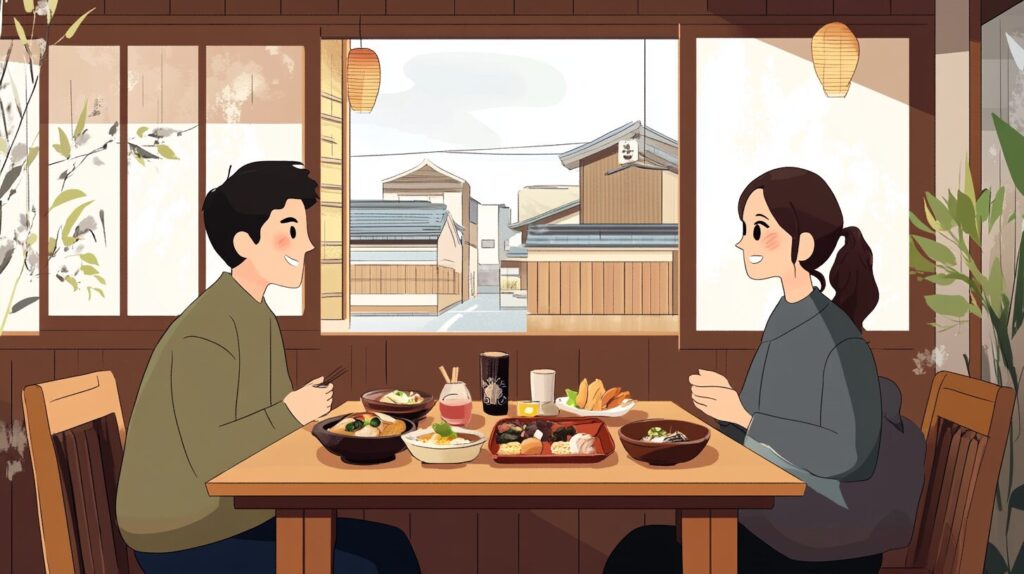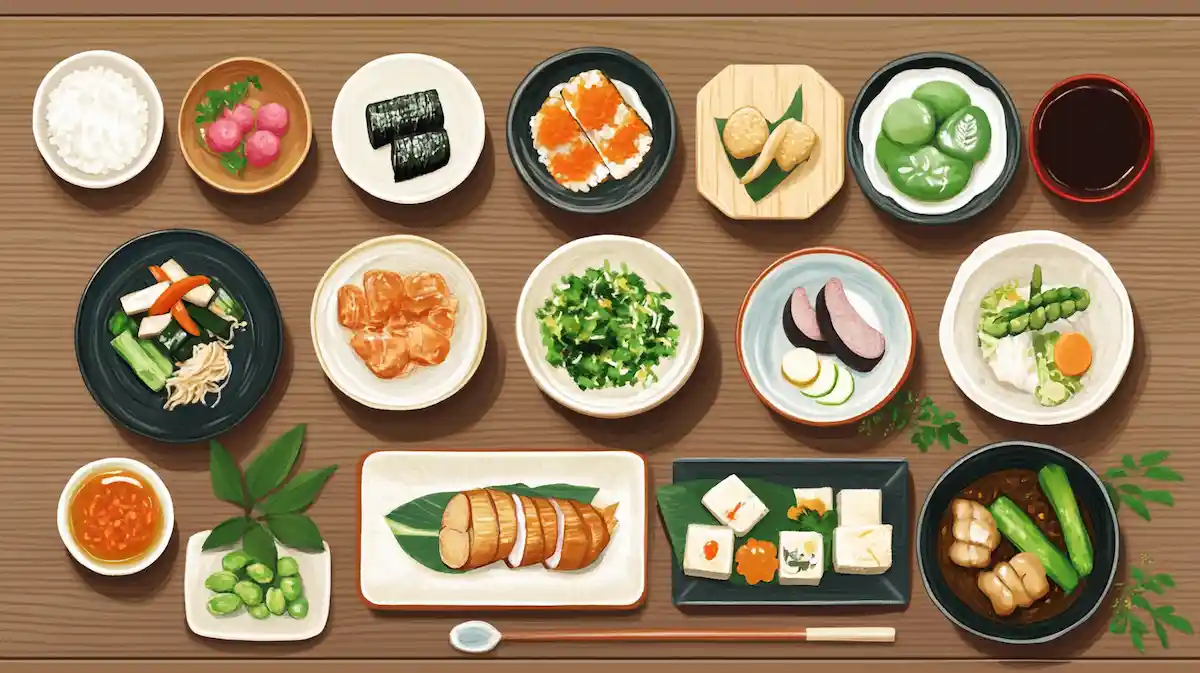京都の家庭料理 おばんざいを英語で説明・紹介するための基本情報と、英会話に役立つ表現をシンプルでわかりやすい英語で紹介します。
英会話ダイアローグ・概要・10の質問を通して、おばんざいに関する英語表現を学びます。
英語
英会話ダイアローグを読む前に知っておくと良い前提知識と情報です。
- おばんざいとは(基本的な定義)
- おばんざいは 京都の家庭料理 のこと
- 旬の食材を使い、シンプルな調理法で作られる料理
- 特に 京野菜、豆腐、海藻、魚 などがよく使われ、だしの旨味を活かした 優しい味付け が特徴
- おばんざいの特徴
- 旬の食材を使う: 季節ごとの新鮮な食材を使い、自然の恵みを味わう。
- 健康的で栄養バランスが良い : 食物繊維が豊富で、低脂肪の食材が多い
- 「もったいない精神」: 食材を無駄にせず、すべて使い切る工夫がある
- 簡単で作り置きができる : 忙しい人でも手軽に作れて、保存が効く料理が多い
- 京都の文化や歴史と深い関係がある : 京都の町家文化や商人の生活に根付いた料理
- 代表的なおばんざいの料理
- ひじきの煮物:ひじき海藻を大豆や人参と煮た料理
- 白和え:潰した豆腐と野菜を和えた和え物
- 茄子の煮浸し:揚げた茄子を出汁で煮浸した料理
- ちりめん山椒:ちりめんじゃこと山椒を炒めた佃煮
- おからの炒り煮 : 豆腐を作る際の「おから」を炒め煮にした料理、食品ロスを減らす工夫の一つ
- 「もったいない精神」とおばんざいの関係
- おばんざいは、京都の人々の 「もったいない精神」 に基づいた料理
- 食材のすべてを無駄なく使うことを大切にする
- 例えば 野菜の皮を漬物にする、おからを別の料理にする などの工夫がある
- おばんざいが京都の歴史と結びついている理由
- 京都は 昔から商人や職人の町 で、簡単で栄養のある食事が必要であった
- そのため、短時間で作れて、保存がきく 「おばんざい」 のスタイルが発展
- 京都は お寺が多い都市 でもあるため、精進料理(肉や魚を使わない料理)の影響も受けている
- おばんざいを食べられる場所(京都)
- 居酒屋 : おばんざいを小鉢に分けて提供する店が多い。
- 町家カフェ : 京都の古民家を改装したカフェで、定食スタイルのおばんざいが楽しめる
- 家庭料理の店 : 観光客向けではなく、地元の人が通うような店で本格的なおばんざいが味わえる
2人がおばんざいについて話しています。
おばんざいの特徴、代表的な料理、健康面での利点、文化的背景などを話題にしています。
会話 / dialogue

Hey Key, I’ve been really interested in Kyoto food lately. I keep hearing about this thing called obanzai. Do you know much about it?

Oh yeah! Obanzai is a traditional home-style cuisine from Kyoto. It’s simple but really deep in flavor. You can find it in many local restaurants and even at home.

So it’s different from kaiseki cuisine, right? Kaiseki seems kind of fancy.

Exactly. Kaiseki is high-class and artistic, but obanzai is everyday food—healthy, practical, and deeply connected to Kyoto’s lifestyle.

That sounds cool. What kind of ingredients are used in obanzai?

Mostly seasonal and local ingredients, like Kyoto vegetables, tofu, seaweed, and fish. The cooking method is simple—steaming, simmering, or pickling—to keep the natural flavors.

So it’s pretty healthy then?

Super healthy! It’s full of fiber, low in fat, and often uses fermented foods like miso and pickles, which are great for digestion.

That’s awesome. Do you have any favorite obanzai dishes?

Hmm… I love Hijiki no Nimono—it’s hijiki seaweed simmered with carrots and soybeans. It’s slightly sweet and full of nutrients.

That sounds good. I should try it. Any other must-try dishes?

Oh, definitely! Shiraae is great—it’s a mashed tofu salad with vegetables. Also, Nasu no Nibitashi—eggplant fried and then soaked in dashi. It tastes amazing when it’s cold.

I love eggplant! I think I’d enjoy that.

You probably would. And if you like a bit of a kick, Chirimen Sansho is nice—tiny dried fish cooked with Japanese pepper. It’s often eaten with rice.

Wow, these all sound delicious. So what makes obanzai so special?

One cool thing is the mottainai spirit. It means “no waste.” Kyoto people use every part of an ingredient—like making pickles from vegetable peels or using okara, the leftover soy pulp from tofu-making.

That’s really sustainable. It’s like Kyoto’s way of respecting nature through food.

Exactly! And another reason obanzai is special is its history. Kyoto used to be a busy merchant city, so people needed easy-to-make but nutritious meals. That’s how obanzai developed.

I love how food can tell the story of a place. So, where can I try real obanzai?

There are plenty of great places! Some izakayas and small restaurants serve obanzai as part of a set meal. Kyoto cafés sometimes offer obanzai-style lunch too.

Nice! I’ll have to check them out. Or maybe I should try making obanzai at home.

That’s a great idea! It’s simple to cook. Just get some Kyoto-style dashi, use fresh seasonal ingredients, and don’t over-season.

Sounds doable! I might start with Nasu no Nibitashi. I really want to taste that.

Good choice! And if you ever need a taste tester, I’m happy to help!

Haha, I’ll take you up on that! Thanks for teaching me about obanzai, Key.

No problem! Enjoy your Kyoto food journey!
概要 / Overview
「おばんざい」について、理解を深めるための「英語での概要」です。
おばんざい

What is Obanzai?
Obanzai is a traditional home-style cuisine from Kyoto, Japan. It is simple, healthy, and made with seasonal and local ingredients. People in Kyoto have been eating obanzai for centuries, and it is still an important part of their daily meals. Unlike kaiseki, which is a formal and artistic style of Japanese food, obanzai is everyday cooking that focuses on nutrition and natural flavors.
Ingredients Used in Obanzai
Obanzai uses fresh and seasonal ingredients. Common ingredients include Kyoto vegetables, tofu, seaweed, and fish. These ingredients are cooked in simple ways, such as steaming, simmering, or pickling. The goal is to keep the natural taste of the food. The seasoning is also light, using dashi (Japanese soup stock), soy sauce, miso, and mirin. Because of this, obanzai is not only delicious but also good for health.
Famous Obanzai Dishes
There are many kinds of obanzai dishes. Some popular ones are:
•Hijiki no Nimono: A dish made with hijiki seaweed, carrots, and soybeans simmered in a light broth.
•Shiraae: A mashed tofu salad with vegetables like spinach and carrots.
•Nasu no Nibitashi: Fried eggplant soaked in dashi, which tastes great when eaten cold.
•Chirimen Sansho: Tiny dried fish cooked with Japanese pepper, often eaten with rice.
•Okara no Irini: Stir-fried soy pulp, a dish that reduces food waste and is full of nutrients.
The “Mottainai” Spirit
One special thing about obanzai is the idea of “mottainai,” which means “no waste.” Kyoto people use every part of an ingredient. For example, they make pickles from vegetable peels and use okara, the leftover soy pulp from tofu-making. This makes obanzai an eco-friendly and sustainable way of cooking.
Where to Eat Obanzai
Obanzai can be found in many places in Kyoto. Some izakayas (Japanese pubs) serve small plates of obanzai, and traditional Kyoto cafés offer obanzai lunch sets. Some local restaurants focus only on obanzai, giving visitors a chance to taste real home-style Kyoto food.
Conclusion
Obanzai is a simple but meaningful part of Kyoto’s food culture. It is healthy, delicious, and connected to history and sustainability. If you visit Kyoto, trying obanzai is a great way to experience the city’s unique flavors and traditions.
10の質問 / 10 questions
「おばんざい」について、理解を深めるための「英語での10の質問」です。
1: What is obanzai?
Obanzai is a traditional home-style cuisine from Kyoto, Japan. It uses seasonal and local ingredients and focuses on simple cooking methods to bring out natural flavors.
2: How is obanzai different from kaiseki cuisine?
Kaiseki cuisine is a formal and artistic style of Japanese food, often served in high-end restaurants. Obanzai, on the other hand, is everyday home cooking that is simpler, more practical, and focused on nutrition.
3: What ingredients are commonly used in obanzai?
Obanzai often includes Kyoto vegetables, tofu, seaweed, fish, and fermented foods like miso and pickles. The ingredients are chosen based on the season to ensure freshness.
4: What are some typical obanzai dishes?
Some common obanzai dishes include hijiki no nimono (simmered hijiki seaweed), shiraae (mashed tofu salad), nasu no nibitashi (fried eggplant in dashi), and chirimen sansho (dried fish with Japanese pepper).
5: What is the cooking style of obanzai?
Obanzai is cooked using simple methods such as steaming, simmering, and pickling. The seasoning is light, mainly using dashi, soy sauce, miso, and mirin to keep the natural taste of the ingredients.
6: What is the meaning of “mottainai” in relation to obanzai?
“Mottainai” means “no waste” in Japanese. In obanzai, every part of the ingredient is used, such as making pickles from vegetable peels or using leftover soy pulp from tofu-making.
7: Why is obanzai considered a healthy food?
Obanzai is high in fiber, low in fat, and often includes fermented foods that help digestion. The use of fresh, seasonal ingredients makes it a well-balanced and nutritious meal.
8: Where can you eat obanzai in Kyoto?
Obanzai can be found in izakayas (Japanese pubs), traditional Kyoto cafés, and local restaurants. Some places specialize in obanzai, offering set meals with a variety of small dishes.
9: How has Kyoto’s history influenced obanzai?
Kyoto was a merchant city where people were busy, so they needed simple and nutritious meals. Obanzai developed as a practical way to prepare food that could be made quickly and stored easily.
10: Can obanzai be made at home?
Yes, obanzai is easy to cook at home. Using Kyoto-style dashi and seasonal ingredients, anyone can prepare obanzai by keeping the seasoning light and focusing on simple cooking techniques.

和訳付
会話 / dialogue

Hey Key, I’ve been really interested in Kyoto food lately. I keep hearing about this thing called obanzai. Do you know much about it?
なあキー、最近京都の食べ物にすごく興味があるんだ。おばんざい っていうのをよく耳にするんだけど、詳しく知ってる?

Oh yeah! Obanzai is a traditional home-style cuisine from Kyoto. It’s simple but really deep in flavor. You can find it in many local restaurants and even at home.
もちろん!おばんざいは京都の伝統的な家庭料理だよ。シンプルだけど、すごく味わい深いんだ。地元のレストランでも、家庭でもよく食べられてるよ。

So it’s different from kaiseki cuisine, right? Kaiseki seems kind of fancy.
じゃあ、懐石料理とは違うんだよね?懐石料理って、ちょっと高級なイメージがあるんだけど。

Exactly. Kaiseki is high-class and artistic, but obanzai is everyday food—healthy, practical, and deeply connected to Kyoto’s lifestyle.
その通り。懐石料理は高級で芸術的な料理だけど、おばんざいは日常的な食事なんだ。健康的で実用的だし、京都の生活に根付いてるよ。

That sounds cool. What kind of ingredients are used in obanzai?
それ、いいね。おばんざいにはどんな食材が使われるの?

Mostly seasonal and local ingredients, like Kyoto vegetables, tofu, seaweed, and fish. The cooking method is simple—steaming, simmering, or pickling—to keep the natural flavors.
主に旬の食材や地元の食材が使われるよ。京野菜、豆腐、海藻、魚なんかがよく使われるね。調理法もシンプルで、蒸す、煮る、漬けるといった方法で素材の味を活かしてるんだ。

So it’s pretty healthy then?
じゃあ、すごく健康的なんだね?

Super healthy! It’s full of fiber, low in fat, and often uses fermented foods like miso and pickles, which are great for digestion.
めちゃくちゃ健康的だよ!食物繊維が豊富で脂肪分が少ないし、味噌や漬物みたいな発酵食品もよく使われるから、消化にもいいんだ。

That’s awesome. Do you have any favorite obanzai dishes?
それはすごいな。キーの好きなおばんざいの料理ってある?

Hmm… I love Hijiki no Nimono—it’s hijiki seaweed simmered with carrots and soybeans. It’s slightly sweet and full of nutrients.
うーん… ひじきの煮物 かな。ひじきをにんじんや大豆と一緒に煮た料理なんだけど、ほんのり甘くて栄養たっぷりだよ。

That sounds good. I should try it. Any other must-try dishes?
それ、美味しそうだな。食べてみたい。他にもおすすめの料理ってある?

Oh, definitely! Shiraae is great—it’s a mashed tofu salad with vegetables. Also, Nasu no Nibitashi—eggplant fried and then soaked in dashi. It tastes amazing when it’s cold.
もちろん!白和え なんかも美味しいよ。豆腐をすりつぶして野菜と和えたサラダみたいな料理なんだ。それから なすの煮びたし もおすすめ。なすを揚げてからだしに浸してるんだけど、冷やして食べるとすごく美味しいよ。

I love eggplant! I think I’d enjoy that.
俺、なす大好きなんだ!それ、絶対気に入ると思う。

You probably would. And if you like a bit of a kick, Chirimen Sansho is nice—tiny dried fish cooked with Japanese pepper. It’s often eaten with rice.
きっと気に入るよ。それに、ちょっとピリッとした味が好きなら ちりめん山椒 もいいよ。小さな干し魚を山椒と一緒に炊いたもので、ご飯と一緒に食べると最高なんだ。

Wow, these all sound delicious. So what makes obanzai so special?
わあ、どれも美味しそうだな。で、おばんざいの特別な魅力って何?

One cool thing is the mottainai spirit. It means “no waste.” Kyoto people use every part of an ingredient—like making pickles from vegetable peels or using okara, the leftover soy pulp from tofu-making.
一つ面白いのは もったいない の精神だよ。「無駄にしない」って意味なんだけど、京都の人は食材のすべてを活用するんだ。例えば、野菜の皮を漬物にしたり、豆腐を作るときに出るおからを使ったりするんだよ。

That’s really sustainable. It’s like Kyoto’s way of respecting nature through food.
すごく持続可能な考え方だね。食を通じて自然を大切にする京都のスタイルって感じがする。

Exactly! And another reason obanzai is special is its history. Kyoto used to be a busy merchant city, so people needed easy-to-make but nutritious meals. That’s how obanzai developed.
その通り!それに、おばんざいが特別なのは歴史があるからなんだ。昔の京都は商人の町だったから、簡単に作れて栄養のある食事が求められてたんだよ。だから、おばんざいが発展したんだ。

I love how food can tell the story of a place. So, where can I try real obanzai?
料理がその土地の歴史を語るって、すごくいいよね。本場のおばんざいを食べるなら、どこがおすすめ?

There are plenty of great places! Some izakayas and small restaurants serve obanzai as part of a set meal. Kyoto cafés sometimes offer obanzai-style lunch too.
美味しいお店がたくさんあるよ!居酒屋や小さなレストランでは、おばんざいのセットを出してるところが多いし、京都のカフェでもおばんざい風のランチを提供してることがあるよ。

Nice! I’ll have to check them out. Or maybe I should try making obanzai at home.
いいね!ぜひ行ってみたいな。でも、自分で作ってみるのも面白そうだな。

That’s a great idea! It’s simple to cook. Just get some Kyoto-style dashi, use fresh seasonal ingredients, and don’t over-season.
それはいいね!作るのも簡単だよ。京風のだしを用意して、新鮮な旬の食材を使って、味付けを控えめにすればいいんだ。

Sounds doable! I might start with Nasu no Nibitashi. I really want to taste that.
それならできそう!まずは なすの煮びたし から始めてみようかな。すごく食べてみたい!

Good choice! And if you ever need a taste tester, I’m happy to help!
いい選択だね!もし味見が必要なら、喜んで手伝うよ!

Haha, I’ll take you up on that! Thanks for teaching me about obanzai, Key.
ハハ、それは助かる!おばんざいのことを教えてくれてありがとう、キー!

No problem! Enjoy your Kyoto food journey!
どういたしまして!京都の食の旅を楽しんでね!
概要 / Overview
おばんざい

What is Obanzai?
Obanzai is a traditional home-style cuisine from Kyoto, Japan. It is simple, healthy, and made with seasonal and local ingredients. People in Kyoto have been eating obanzai for centuries, and it is still an important part of their daily meals. Unlike kaiseki, which is a formal and artistic style of Japanese food, obanzai is everyday cooking that focuses on nutrition and natural flavors.
おばんざいとは?
おばんざいは、日本の京都で生まれた伝統的な家庭料理です。シンプルで健康的であり、旬の地元の食材を使って作られます。京都の人々は何世紀にもわたっておばんざいを食べており、今でも日常の食事として大切にされています。懐石料理のような格式の高い料理とは異なり、おばんざいは栄養と自然な風味を重視した家庭料理です。
Ingredients Used in Obanzai
Obanzai uses fresh and seasonal ingredients. Common ingredients include Kyoto vegetables, tofu, seaweed, and fish. These ingredients are cooked in simple ways, such as steaming, simmering, or pickling. The goal is to keep the natural taste of the food. The seasoning is also light, using dashi (Japanese soup stock), soy sauce, miso, and mirin. Because of this, obanzai is not only delicious but also good for health.
おばんざいに使われる食材
おばんざいには、新鮮で旬の食材が使われます。代表的な食材には、京野菜、豆腐、海藻、魚などがあります。調理方法はシンプルで、蒸す、煮る、漬けるといった方法が一般的です。食材本来の味を活かすことが大切とされています。味付けも優しく、だし、醤油、味噌、みりんを控えめに使います。そのため、おばんざいは美味しいだけでなく、健康にも良い料理です。
Famous Obanzai Dishes
There are many kinds of obanzai dishes. Some popular ones are:
•Hijiki no Nimono: A dish made with hijiki seaweed, carrots, and soybeans simmered in a light broth
•Shiraae: A mashed tofu salad with vegetables like spinach and carrots.
•Nasu no Nibitashi: Fried eggplant soaked in dashi, which tastes great when eaten cold.
•Chirimen Sansho: Tiny dried fish cooked with Japanese pepper, often eaten with rice.
•Okara no Irini: Stir-fried soy pulp, a dish that reduces food waste and is full of nutrients.
代表的なおばんざいの料理
おばんざいには、さまざまな種類の料理があります。代表的なものは以下の通りです。
•ひじきの煮物:ひじき、にんじん、大豆をだしで煮込んだ料理で、優しい甘みが特徴。
•白和え:すりつぶした豆腐とほうれん草やにんじんなどの野菜を和えたサラダ風の料理。
•なすの煮びたし:揚げたなすをだしに浸して冷やした料理で、冷たいまま食べると美味しい。
•ちりめん山椒:ちりめんじゃこ(小さな干し魚)を山椒と一緒に煮込んだもので、ご飯によく合う。
•おからの炒り煮:豆腐を作る際に出る「おから」を炒め煮にした料理で、食品ロスを減らしつつ栄養価も高い。
The “Mottainai” Spirit
One special thing about obanzai is the idea of “mottainai,” which means “no waste.” Kyoto people use every part of an ingredient. For example, they make pickles from vegetable peels and use okara, the leftover soy pulp from tofu-making. This makes obanzai an eco-friendly and sustainable way of cooking.
「もったいない精神」
おばんざいの特徴の一つに、「もったいない精神」があります。これは「無駄にしない」という考え方です。京都の人々は食材のすべてを活用する工夫をしてきました。例えば、野菜の皮を漬物にしたり、豆腐を作る際に出るおからを料理に活かしたりします。こうした工夫により、おばんざいは環境に優しく、持続可能な料理のスタイルとなっています。
Where to Eat Obanzai
Obanzai can be found in many places in Kyoto. Some izakayas (Japanese pubs) serve small plates of obanzai, and traditional Kyoto cafés offer obanzai lunch sets. Some local restaurants focus only on obanzai, giving visitors a chance to taste real home-style Kyoto food.
おばんざいを食べられる場所
おばんざいは、京都のさまざまな場所で楽しむことができます。居酒屋では、小皿に分けられたおばんざいを提供する店が多くあります。また、京都の伝統的なカフェでは、おばんざいのランチセットを楽しめることもあります。さらに、おばんざい専門の家庭料理の店もあり、観光客が本場の味を体験できる貴重な場所となっています。
Conclusion
Obanzai is a simple but meaningful part of Kyoto’s food culture. It is healthy, delicious, and connected to history and sustainability. If you visit Kyoto, trying obanzai is a great way to experience the city’s unique flavors and traditions.
まとめ
おばんざいは、シンプルでありながら京都の食文化の重要な一部です。健康的で美味しく、歴史や持続可能な考え方とも深く結びついています。京都を訪れる際には、おばんざいを味わうことで、京都の独特な食文化や伝統を体験するのがおすすめです。
10の質問 / 10 questions
1: What is obanzai?
おばんざいとは何ですか?
Obanzai is a traditional home-style cuisine from Kyoto, Japan. It uses seasonal and local ingredients and focuses on simple cooking methods to bring out natural flavors.
おばんざいは、日本の京都の伝統的な家庭料理です。旬の地元の食材を使い、シンプルな調理法で素材の自然な味を引き出すことを重視しています。
2: How is obanzai different from kaiseki cuisine?
おばんざいは懐石料理とどう違いますか?
Kaiseki cuisine is a formal and artistic style of Japanese food, often served in high-end restaurants. Obanzai, on the other hand, is everyday home cooking that is simpler, more practical, and focused on nutrition.
懐石料理は格式が高く芸術的な日本料理で、高級レストランなどで提供されることが多いです。一方、おばんざいは家庭で日常的に作られる料理で、よりシンプルで実用的、そして栄養を重視しています。
3: What ingredients are commonly used in obanzai?
おばんざいにはどのような食材がよく使われますか?
Obanzai often includes Kyoto vegetables, tofu, seaweed, fish, and fermented foods like miso and pickles. The ingredients are chosen based on the season to ensure freshness.
おばんざいには、京野菜、豆腐、海藻、魚、味噌や漬物などの発酵食品がよく使われます。食材は季節ごとに選ばれ、新鮮さが保たれています。
4: What are some typical obanzai dishes?
代表的なおばんざいの料理にはどのようなものがありますか?
Some common obanzai dishes include hijiki no nimono (simmered hijiki seaweed), shiraae (mashed tofu salad), nasu no nibitashi (fried eggplant in dashi), and chirimen sansho (dried fish with Japanese pepper).
代表的なおばんざいの料理には、ひじきの煮物(ひじきと野菜の煮込み)、白和え(豆腐と野菜の和え物)、なすの煮びたし(揚げたなすのだし漬け)、ちりめん山椒(山椒と一緒に炊いたちりめんじゃこ)などがあります。
5: What is the cooking style of obanzai?
おばんざいの調理法の特徴は何ですか?
Obanzai is cooked using simple methods such as steaming, simmering, and pickling. The seasoning is light, mainly using dashi, soy sauce, miso, and mirin to keep the natural taste of the ingredients.
おばんざいは、蒸す、煮る、漬けるなどのシンプルな調理法が特徴です。味付けは控えめで、主にだし、醤油、味噌、みりんを使用し、食材の自然な味を活かします。
6: What is the meaning of “mottainai” in relation to obanzai?
おばんざいにおける「もったいない」の意味は何ですか?
“Mottainai” means “no waste” in Japanese. In obanzai, every part of the ingredient is used, such as making pickles from vegetable peels or using okara, the leftover soy pulp from tofu-making.
「もったいない」は日本語で「無駄にしない」という意味です。おばんざいでは、野菜の皮を漬物にしたり、豆腐を作るときに出るおからを料理に活用したりすることで、食材を無駄なく使います。
7: Why is obanzai considered a healthy food?
おばんざいはなぜ健康的な食事とされているのですか?
Obanzai is high in fiber, low in fat, and often includes fermented foods that help digestion. The use of fresh, seasonal ingredients makes it a well-balanced and nutritious meal.
おばんざいは食物繊維が豊富で脂肪分が少なく、消化を助ける発酵食品がよく使われています。また、旬の新鮮な食材を使用するため、栄養バランスの取れた健康的な食事となります。
8: Where can you eat obanzai in Kyoto?
京都ではどこでおばんざいを食べることができますか?
Obanzai can be found in izakayas (Japanese pubs), traditional Kyoto cafés, and local restaurants. Some places specialize in obanzai, offering set meals with a variety of small dishes.
おばんざいは、居酒屋、京都の伝統的なカフェ、地元のレストランなどで楽しむことができます。中にはおばんざい専門の店もあり、さまざまな小鉢がセットになった定食を提供しているところもあります。
9: How has Kyoto’s history influenced obanzai?
京都の歴史はおばんざいにどのような影響を与えましたか?
Kyoto was a merchant city where people were busy, so they needed simple and nutritious meals. Obanzai developed as a practical way to prepare food that could be made quickly and stored easily.
京都は商人の町だったため、人々は忙しく、簡単で栄養のある食事が求められました。おばんざいは、素早く作れて保存がきく実用的な料理として発展しました。
10: Can obanzai be made at home?
おばんざいは家庭で作ることができますか?
Yes, obanzai is easy to cook at home. Using Kyoto-style dashi and seasonal ingredients, anyone can prepare obanzai by keeping the seasoning light and focusing on simple cooking techniques.
はい、おばんざいは家庭でも簡単に作れます。京風のだしと旬の食材を使い、味付けを控えめにし、シンプルな調理法を意識すれば、誰でも美味しく作ることができます。

words & phrases
英会話ダイアローグと関連情報に出てきた単語・フレーズです(例文は各3つ)。

fancy : 形容詞
意味: 華やかな、上品な、高級な。Stylish, expensive, or decorative.
(懐石料理が高級で芸術的であることを説明する際に使用)
例文:
- Kaiseki cuisine is very fancy and beautifully presented.
「懐石料理はとても高級で、美しく盛り付けられています。」 - He took me to a fancy restaurant for my birthday.
「彼は私の誕生日に高級レストランへ連れて行ってくれました。」 - She wore a fancy dress to the party.
「彼女はパーティーに華やかなドレスを着ていきました。」
simmer : 動詞
意味: 弱火で煮る、コトコト煮込む。To cook food gently at a low temperature.
(おばんざいの煮物料理(ひじきの煮物など)を説明する際に使用)
例文:
- The hijiki is simmered with soybeans and carrots.
「ひじきは大豆とにんじんと一緒にコトコト煮込まれます。」 - Let the soup simmer for 20 minutes.
「スープを20分ほど弱火で煮込んでください。」 - She simmered the sauce until it thickened.
「彼女はソースがとろみをつけるまで弱火で煮込みました。」
pickle : 動詞
意味: 漬ける、漬物にする。To preserve food in vinegar or saltwater.
(もったいない精神の一例として、野菜の皮を漬物にする方法を説明する際に使用)
例文:
- In Kyoto, people pickle vegetable peels to avoid waste.
「京都では、無駄をなくすために野菜の皮を漬物にします。」 - My grandmother loves to pickle cucumbers.
「私の祖母はきゅうりを漬物にするのが好きです。」 - He pickled some radishes in vinegar and salt.
「彼は大根を酢と塩で漬けました。」
ferment : 動詞
意味: 発酵させる。To undergo a chemical change due to bacteria or yeast.
(文脈での使用: おばんざいの健康的な特徴として、味噌や漬物などの発酵食品が消化を助ける点を説明する際に使用)
例文:
- Miso is made by fermenting soybeans.
「味噌は大豆を発酵させて作られます。」 - The rice was left to ferment for three days.
「その米は3日間発酵させられました。」 - Many traditional Japanese foods are fermented to enhance flavor.
「日本の伝統的な食品の多くは、風味を高めるために発酵させられます。」
mashed : 形容詞
意味: すりつぶした、つぶした。Crushed or pressed into a soft and smooth texture.
(おばんざいの白和え(豆腐と野菜の和え物)を説明する際に使用)
例文:
- Shiraae is made with mashed tofu and vegetables.
「白和えは、すりつぶした豆腐と野菜で作られます。」 - She served mashed potatoes with gravy.
「彼女はマッシュポテトにグレービーソースをかけて出しました。」 - The baby eats mashed carrots and rice.
「赤ちゃんはすりつぶしたにんじんとご飯を食べます。」
